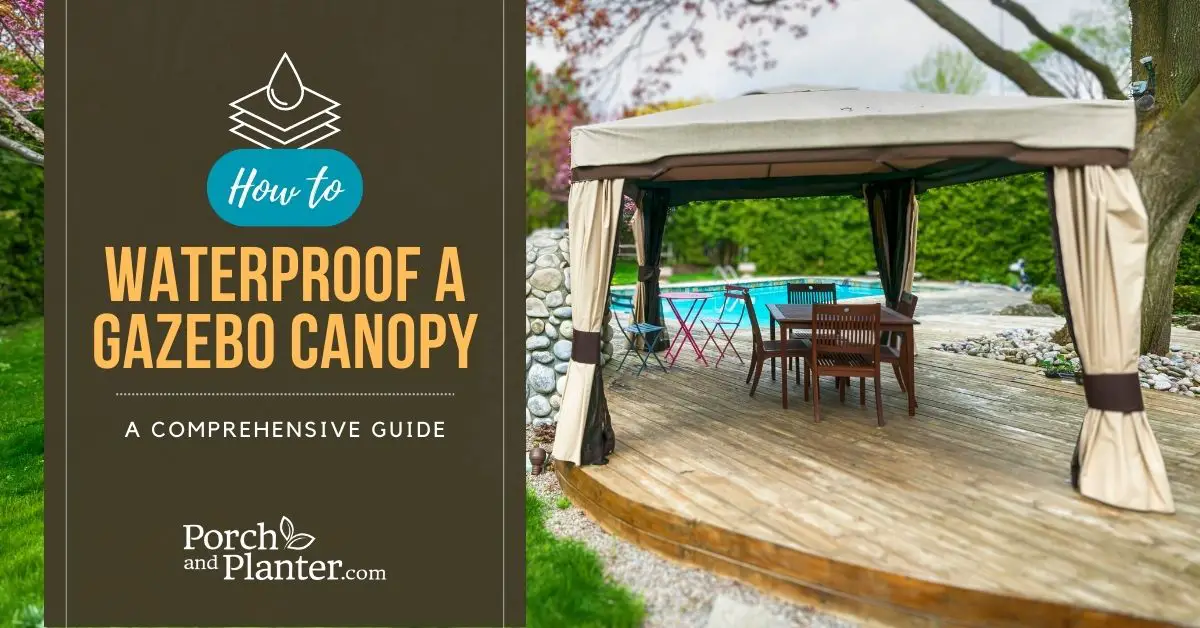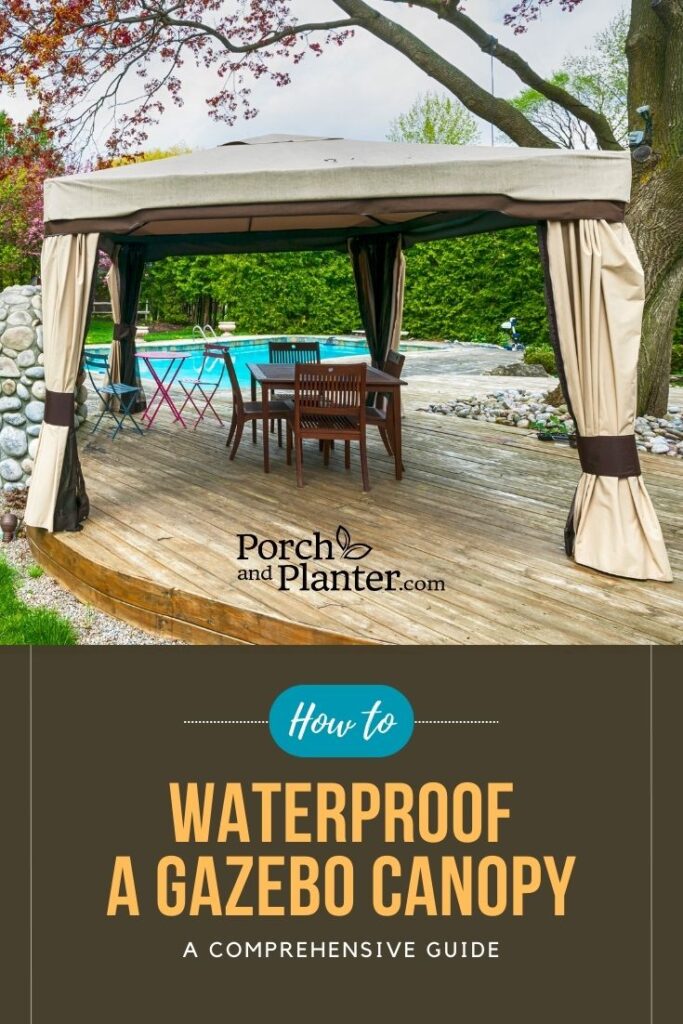How to Waterproof a Gazebo Canopy: A Comprehensive Guide

Having a gazebo in your backyard can be a great way to enjoy the outdoors while still being protected from the elements. However, if your gazebo canopy is not waterproof, it can be difficult to enjoy during rainy weather. Luckily, there are several ways to waterproof your gazebo canopy and make sure that you can still enjoy your outdoor space, rain or shine.
The best way to waterproof your gazebo canopy is to use a waterproofing spray, such as a silicone spray. This can be applied to the canopy fabric before you set it up, or after it’s already been set up. Waterproofing sprays create a barrier that repels water, so if any rain or water does happen to hit your canopy, it will simply bead up and roll right off.
Choosing the Right Waterproofing Method for Your Gazebo
There are several waterproofing methods available for gazebo canopies, and it’s important to choose the one that suits your specific needs. Let’s take a closer look at some common methods:
- Spray-on sealants: These are typically silicone-based products that create a barrier against water. They can be applied directly to the fabric, metal, or vinyl surfaces of your gazebo canopy, forming a waterproof layer that repels water. Spray-on sealants are easy to apply and can provide effective waterproofing for a wide range of materials.
- Fabric waterproofing sprays: These are specifically designed for fabric canopies and are formulated to penetrate the fibers of the fabric, creating a water-repellent barrier. Fabric waterproofing sprays are usually water-based and can be applied using a spray bottle or a brush. They are ideal for fabric canopies made of materials such as polyester, canvas, or nylon.
- Seam sealers: These are ideal for addressing potential weak points in the seams and stitching of fabric canopies. Seam sealers are typically applied using a brush or an applicator and create a waterproof seal along the seams, preventing water from seeping through.
When choosing a waterproofing method, consider factors such as cost, durability, ease of application, and effectiveness. Keep in mind the specific material of your gazebo canopy and the level of waterproofing you require. It’s always recommended to read and follow the manufacturer’s instructions for the waterproofing product you choose.
Assessing the Canopy
Before waterproofing your gazebo canopy, it’s important to assess its condition. This will help you identify any weak points and leaks that need to be addressed before applying any waterproofing treatment.
Checking for Leaks
The first step in assessing your canopy is to check for any leaks. You can do this by setting up your gazebo and spraying it down with a hose or a power washer. Look for any areas where water is seeping through the fabric. Mark these areas with a piece of tape or a marker so that you can address them later.
Identifying Weak Points
Next, you’ll want to identify any weak points in your canopy. This includes areas that are prone to wear and tear, such as the seams, corners, and edges. Look for any frayed or damaged areas, as well as any spots where the fabric is thinning or starting to deteriorate. Take note of these areas so that you can reinforce them with waterproofing spray or sealant.
Preparing the Canopy
Before you start waterproofing your gazebo canopy, it is essential to clean it properly. You can use a soft-bristled brush, mild soap, and water to clean the canopy. Avoid using harsh chemicals or abrasive materials as they can damage the fabric. Rinse the canopy thoroughly and let it dry completely before proceeding to the next step.
Applying Waterproofing Products
Once your gazebo canopy is cleaned and repaired, it’s time to apply the waterproofing product. Follow the manufacturer’s instructions for the specific waterproofing method you have chosen. Here are some general steps to guide you:
- For spray-on sealants: Shake the canister well and hold it about 6-12 inches away from the surface of the canopy. Spray the product evenly in a sweeping motion, making sure to cover the entire surface. Avoid over-saturating the fabric or creating puddles. Allow the product to dry according to the manufacturer’s recommendations.
- For fabric waterproofing sprays: Apply the product evenly to the fabric surface using a spray bottle or a brush, following the manufacturer’s instructions. Make sure to cover the entire canopy, paying extra attention to seams and stitching. Allow the product to dry completely.
- For seam sealers: Apply the product along the seams and stitching using a brush or an applicator, following the manufacturer’s instructions. Make sure to create a continuous seal along the entire length of the seam. Allow the product to dry and cure according to the manufacturer’s recommendations.
When applying the waterproofing product, use even strokes and ensure that the product is evenly distributed. Avoid over-saturating the fabric or creating puddles, as this can affect the effectiveness of the waterproofing. Take extra care with seams and stitching, as these are common areas where water can penetrate. For metal or vinyl canopies, apply the sealant or adhesive evenly and cover all cracks or gaps to create a continuous waterproof barrier.
Curing and Testing the Waterproofing Application
After applying the waterproofing product, it’s important to allow it to cure or dry completely before exposing your gazebo canopy to water. Follow the manufacturer’s recommendations for curing time, as it may vary depending on the type of product used. Once the waterproofing product has cured, conduct a water test to check for its effectiveness. Use a hose or a sprinkler to simulate rain and check for any leaks or water penetration on the canopy. If any issues or areas requiring additional treatment are identified, address them promptly to ensure that your gazebo canopy is fully waterproofed.
Maintenance and Upkeep
Regular maintenance and upkeep are essential to ensure the longevity and effectiveness of the waterproofing on your gazebo canopy. Here are some tips for maintaining your gazebo canopy’s waterproofing:
- Clean your gazebo canopy regularly to remove dirt, debris, and mildew. Use a mild detergent or a fabric cleaner for fabric canopies, and a mild soap or a metal cleaner for metal or vinyl canopies. Rinse the canopy thoroughly and allow it to dry completely.
- Inspect your canopy regularly for any signs of wear, tear, or damage. Patch any holes or leaks promptly using appropriate materials and techniques. Address any issues or areas that may require additional waterproofing treatment.
- Reapply waterproofing products as needed. Over time, the effectiveness of waterproofing products may diminish due to exposure to weather elements. Follow the manufacturer’s recommendations for reapplication frequency and apply the product accordingly.
- Protect your gazebo canopy from harsh weather conditions and UV rays. Use a gazebo cover or a tarp during extreme weather events or when the canopy is not in use to prevent water damage and sun damage.
Conclusion
In conclusion, waterproofing your gazebo canopy is a crucial step in ensuring its durability and protecting it from moisture damage. By assessing your canopy, choosing the right waterproofing method, properly preparing and applying the product, conducting regular maintenance, and following the tips provided in this comprehensive guide, you can effectively safeguard your gazebo canopy from rain, snow, and other forms of moisture. This investment will extend the lifespan of your gazebo canopy, allowing you to continue enjoying your outdoor space in any weather condition. Don’t overlook the importance of waterproofing your gazebo canopy, and take action to protect your investment and enjoy your gazebo for years to come.





![Are Pavers Safe for a Fire Pit? [ANSWERED]](https://porchandplanter.com/wp-content/uploads/2021/09/Are-Pavers-Safe-for-a-Fire-Pit-768x402.jpg)


